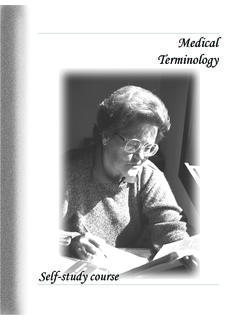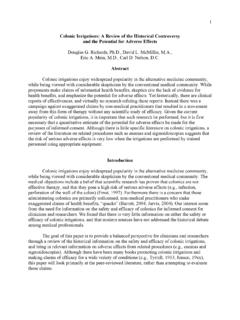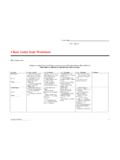Transcription of Urine Drug Testing - Remitigate
1 Urine Drug Testing in Clinical Practice The Art and Science of Patient Care EDITION 6. Target Audience: Healthcare professionals who treat patients with chronic pain Release date: August 31, 2015 Expiration date: August 31, 2017. Estimated time to complete this CME activity: 2 hours Fee: There is no fee to participate in this activity Presented by the Center for Independent Healthcare Education Supported by an educational grant from Millennium Research Institute AUTHORS Despite potentially serious outcomes from UDT for pain patients (eg, dismissal or changes to the treatment plan), clinicians often lack Douglas L. Gourlay, MD, MSc, FRCPC, FASAM training in the use of UDT, and UDT is often underused or used Former Director inappropriately in clinical practice. Before ordering UDT, clinicians Pain and Chemical Dependency Division should understand methods of Testing , the potential benefits and Wasser Pain Management Centre limitations of UDT, and how to interpret results, so that they can Toronto, Ontario, Canada rationally employ patient-centered UDT in clinical practice.
2 This monograph will assist clinicians to appropriately use UDT to improve Howard A. Heit, MD, FACP, FASAM. patient care. Assistant Clinical Professor of Medicine Georgetown University School of Medicine Washington, DC LEARNING OBJECTIVES. Healthcare professionals participating in this educational activity will Yale H. Caplan, PhD, F-ABFT. be able at its conclusion to: Toxicologist Adjunct Professor 1. Develop a Testing strategy to utilize UDT in the care of patients Department of Pharmaceutical Sciences with chronic pain. University of Maryland School of Pharmacy 2. Distinguish between types of UDT and formulate practical Director, National Scientific Services strategies to determine the appropriate test to order and Baltimore, Maryland accurately interpret UDT results. 3. Create a practice plan to maximize the utility of UDT results by PROGRAM REVIEWER charting the interpretation, discussing unexpected results with Catherine Ruth Morris, MD, CCFP, FCFP patients, and consulting with a toxicologist/laboratory director when necessary to interpret unexpected results.
3 Assistant Clinical Professor Department of Family Medicine McMaster University TARGET AUDIENCE. Hamilton, Ontario, Canada Healthcare professionals who treat patients with chronic pain PROGRAM OVERVIEW ACCREDITATION. There remains significant controversy as to whether some well- selected and carefully monitored patients with chronic pain experience Physicians improved function, meaningful pain relief, and improved quality of life This activity has been planned and implemented in accordance with from opioid therapy. But for others, opioid treatment may result in the accreditation requirements and policies of the Accreditation misuse, abuse, and diversion; and may not improve function. Council for Continuing Medical Education (ACCME) through the joint Therefore, proper prescribing of controlled substances is critical to providership of the Center for Independent Healthcare Education and patients' health and to safeguard society against abuse and diversion.
4 PharmaCom Group, Inc. Center for Independent Healthcare A number of organizations and agencies have developed Education is accredited by the ACCME to provide continuing medical recommendations and guidelines that include the use of Urine drug education for physicians. Testing (UDT) as a tool to assist clinicians to responsibly prescribe Center for Independent Healthcare Education designates this opioids when managing chronic pain; for example, clinical practice Enduring material for a maximum of AMA PRA Category 1. guidelines for chronic pain management published by the American Credit(s) . Physicians should claim only the credit commensurate Pain Society/American Academy of Pain Medicine and the Department with the extent of their participation in the activity. of Veterans Affairs/Department of Defense include a provision for UDT. However, neither guideline provides instruction for how UDT should be Physician Assistants performed in clinical practice nor how to interpret UDT results.
5 In addition many state medical boards/agencies have developed policies or AAPA accepts AMA PRA Category 1 Credit for the PRA from guidelines that require or suggest the use of UDT in certain situations. organizations accredited by ACCME. Nurse Practitioners DISCLOSURE OF FINANCIAL INTEREST. Nurse Practitioners will receive certificate of AMA PRA Category 1 SUMMARY. Credit as this is an ACCME accredited program and its accreditation Howard A. Heit, MD (author/planner) has relevant financial is recognized by Nurse Practitioner boards. relationships with commercial interests: For questions regarding accreditation, please contact Consultant: Millennium Health Dr Heit does not discuss the off-label use of a product. Release date Yale H. Caplan, PhD (author/planner) has relevant financial August 31, 2015 relationships with commercial interests: Consultant: Aegis Sciences Corporation Expiration date Dr Caplan does not discuss the off-label use of a product.
6 August 31, 2017. No other authors, planners, or content reviewers have any relevant Fee financial relationships to disclose. No other authors will discuss off- label use of a product. There is no fee to participate in this activity Content review confirmed that the content was developed in a fair, balanced manner free from commercial bias. Disclosure of a METHOD OF PARTICIPATION AND relationship is not intended to suggest or condone commercial bias in INSTRUCTION FOR CREDIT any presentation, but it is made to provide participants with 1. Review the entire CME information including target audience, information that might be of potential importance to their evaluation learning objectives, and disclosures. of a presentation. 2. Read the monograph. 3. Complete the Online Post Test, Evaluation, and Credit SUPPORT GRANT. Application form at This activity is supported by an educational grant from Millennium 4. Please note that to receive credit you must achieve a score of at Research Institute.
7 Least 70%. 5. Certificate of Credit will be emailed within 4 weeks of successful completion of the activity. DISCLOSURE OF CONFLICTS ON INTEREST. Center for Independent Healthcare Education requires faculty, planners, and others who are in a position to control the content of continuing education activities to disclose to the audience any real or apparent conflict of interest related to the activity. All identified conflicts of interest are reviewed and resolved to ensure fair balance, objectivity, and scientific rigor in all activities. The faculty is further required to disclose discussion of off-label uses in their presentations. Relevant relationships include roles such as speaker, author, consultant, independent contractor (including research), employee, investor, advisory committee member, board member, review panelist, and investigator. If a potential speaker or author indicates a possible conflict of interest, the conflict will be resolved by choosing another speaker or author for that topical area, or the slides, handouts, and/or monograph will be reviewed and approved by a qualified commercially- Copyright 2015 PharmaCom Group, Inc.
8 All Rights Reserved. Permission disinterested peer. for accreditation use granted to Center for Independent Healthcare Education. 1. INTRODUCTION. There remains significant controversy as to whether some well-selected and carefully monitored patients with chronic pain experience improved function, meaningful pain relief, and improved quality of life from opioid analgesic therapy. However, opioids are controlled substances that also have the potential for misuse, abuse, addiction, and diversion. A number CONTENTS of organizations and agencies have developed recommendations and guidelines that include the use of Urine drug Testing (UDT) as a tool to assist clinicians to improve patient care and responsibly prescribe opioids when managing chronic For example, clinical practice guidelines for the management of chronic pain published by the American Pain Society (APS)/American Academy of Pain Medicine (AAPM) and the Department of Veterans Affairs (VA)/Department of Defense (DoD).
9 INTRODUCTION 2. include a provision for ;2 However, neither provides instruction for BACKGROUND 3 how UDT should be performed rationally in clinical ;2 In addition, many state medical boards/agencies have developed policies or Urine DRUG Testing METHODS 3 guidelines that require or suggest the use of UDT in certain situations. Immunoassays 3. Any test, including UDT, must meet the basic standards of medical Laboratory-Based Specific Drug Identification 4. necessity if it is to be a credible element of clinical All 3 of the Drug-Class Specific Windows of Detection 6 following elements must be addressed:5. Characteristics of Urine 6 Why was the test ordered? CURRENT USES OF Urine DRUG Testing 7 What results were obtained? Federally Regulated Testing 7 What changes in clinical course were made (including staying Nonregulated Forensic Testing 8 the course, if appropriate) as a result of these test results? Patient-Centered Clinical Urine Drug Testing 8 Failure to ask, answer, and document in the medical record these key elements of medical necessity may leave the clinician open to medico- IMPROVING RELIABILITY OF legal PATIENT-CENTERED CLINICAL Testing 9.
10 Why to Test 10. Whom to Test 12. Any test, including UDT, must meet the basic standards of medical necessity if it is to be a credible element of When to Test 13. clinical care. INTERPRETATION OF UDT RESULTS 14. Immunoassay Cross-Reactivity 15. In addition, not understanding the limitations of Testing , Positive Results 16. overinterpreting the results, or using UDT results in isolation could Negative Results 17 lead to clinical decisions that are detrimental to both the clinician and Caveats to Interpretation 17 the patient, such as adversely altering or even terminating patient care. Myths 19. The sixth edition of this monograph, first published in 2002, serves to Emerging Drugs of Abuse 20 address some of the current issues and controversies surrounding ALTERNATIVE TECHNOLOGIES FOR DRUG UDT. It describes why the use of UDT is at once (1) more complex and Testing : BENEFITS & LIMITATIONS 20 (2) potentially more useful than many clinicians appreciate.





